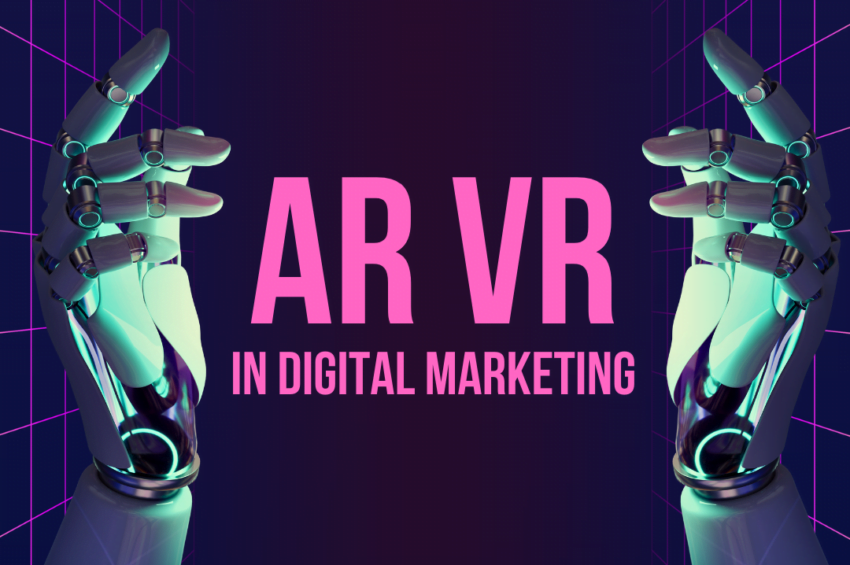
1. Introduction to AR and VR in digital marketing
2. The impact of AR and VR on consumer engagement
3. Enhancing brand storytelling with AR and VR experiences
4. Leveraging AR and VR for immersive product demonstrations
5. Creating interactive and engaging AR and VR ads:
6. Personalizing customer experiences with AR and VR technologies
7. Overcoming challenges and implementing AR and VR strategies in digital marketing
8. The future of AR and VR in the digital marketing landscape
FAQ
The advent of Augmented Reality (AR) and Virtual Reality (VR) technologies has revolutionized the way digital marketing engages with consumers. AR and VR offer immersive and interactive experiences that captivate audiences, enhance brand storytelling, and drive customer engagement. This article explores the growing influence of AR and VR in the realm of digital marketing, examining their impact on consumer behavior, their role in enhancing brand experiences, and their potential to reshape the future of marketing strategies. By delving into the various applications and benefits of AR and VR in digital marketing, businesses can gain valuable insights into leveraging these technologies to create compelling and personalized experiences for their target audience.
1. Introduction to AR and VR in digital marketing
The definition and basics of AR and VR
AR (Augmented Reality) and VR (Virtual Reality) are two exciting technologies that have taken the digital marketing world by storm. AR refers to the integration of digital elements into the real world, enhancing our perception of reality. On the other hand, VR offers a completely immersive experience by creating a virtual environment that users can interact with.
The growth and adoption of AR and VR in digital marketing
Over the years, AR and VR have witnessed tremendous growth and adoption in the digital marketing landscape. With the increasing availability of affordable hardware like smartphones and VR headsets, more consumers are gaining access to these technologies. As a result, forward-thinking marketers have recognized the potential of AR and VR to captivate and engage their target audiences in unique ways.
2. The impact of AR and VR on consumer engagement
Enhancing customer interaction through immersive experiences
AR and VR provide marketers with the tools to create immersive experiences that go beyond traditional advertising methods. By allowing consumers to interact with products or services in a virtual or augmented environment, brands can enhance customer engagement. Whether it’s trying on virtual clothes or exploring a hotel room before booking, these immersive experiences leave a lasting impact on consumers.
Increasing brand loyalty with AR and VR engagement
When brands utilize AR and VR in their marketing strategies, they provide customers with a unique and memorable experience. This not only helps in building brand loyalty but also creates a sense of excitement and exclusivity. By offering something different from the competition, brands can increase customer retention and advocacy, leading to long-term success.
3. Enhancing brand storytelling with AR and VR experiences
Captivating audiences with immersive narratives
AR and VR offer marketers a powerful medium to tell their brand’s story in a more captivating and interactive way. By merging digital elements with real-world scenarios, brands can create immersive narratives that resonate with the audience. This allows for deeper emotional connections and stronger brand associations, making the storytelling experience more memorable and impactful.
Creating memorable brand experiences through AR and VR
With AR and VR, brands can transport consumers into a world where they can fully experience the brand’s values, products, or services. Whether it’s taking a virtual tour of a property, visualizing how furniture fits in their homes, or simulating extreme sports experiences, AR and VR enable brands to create unforgettable moments. These immersive experiences leave a lasting impression on consumers, increasing the chances of brand recall and future engagement.
4. Leveraging AR and VR for immersive product demonstrations
Showcasing products and services with virtual experiences
AR and VR provide marketers with a unique opportunity to showcase their products or services in a virtual environment. This allows customers to experience and explore the features, benefits, and functionalities of a product in a more engaging and interactive way. By incorporating virtual experiences into product demonstrations, brands can effectively communicate their value proposition and differentiate themselves from competitors.
Allowing customers to experience products before purchase
One of the key advantages of AR and VR is the ability to allow customers to experience products before making a purchase. Whether it’s virtually trying on clothes, test driving a car, or visualizing how furniture looks in their homes, these virtual experiences give customers a sense of ownership and confidence in their buying decisions. By reducing uncertainty and increasing satisfaction, AR and VR can positively impact the conversion rates and customer satisfaction levels.5. Driving sales and conversions through AR and VR advertising
5. Creating interactive and engaging AR and VR ads:
Imagine scrolling through your social media feed and stumbling upon an ad that transports you to another world. That’s the power of AR and VR advertising. These technologies have the ability to captivate audiences like never before, making traditional ads look as exciting as a grey wall. By creating interactive and engaging AR and VR ads, businesses can grab the attention of potential customers and skyrocket their sales.
Measuring the impact of AR and VR advertising on sales:
But how do you know if your AR or VR ad is actually making a difference? Well, the good news is that just like any other digital marketing strategy, you can measure the impact of AR and VR advertising on sales. By looking at metrics like click-through rates, conversion rates, and even tracking offline purchases, you can get a clear picture of how much impact your immersive ads are having on your bottom line. So no more guessing games – now you’ll have solid data to back up your marketing efforts.
6. Personalizing customer experiences with AR and VR technologies
Customizing AR and VR experiences based on customer preferences:
We all love feeling special, right? Well, with AR and VR technologies, businesses can take personalization to a whole new level. By customizing AR and VR experiences based on customer preferences, brands can create a truly tailored experience that makes customers feel like they’re being treated as individuals, not just another number in a marketing campaign. Whether it’s showcasing products in a virtual showroom or allowing customers to virtually try on clothes, personalization with AR and VR is the new frontier of customer experience.
Delivering personalized offers and promotions through AR and VR:
Speaking of personalization, how about delivering offers and promotions through AR and VR? With these technologies, businesses can create immersive experiences where customers can interact with virtual coupons, discounts, and exclusive offers. It’s like being inside a digital treasure hunt, with customers feeling like they’ve stumbled upon a secret deal. So if you want to catch your customers’ attention and make them feel special, AR and VR are your golden tickets.
7. Overcoming challenges and implementing AR and VR strategies in digital marketing
Addressing technical and infrastructure requirements:
Now, let’s address the elephant in the virtual room – the technical and infrastructure requirements of AR and VR. Yes, these technologies can be a bit demanding, requiring powerful devices and strong internet connections. But fear not! As technology advances, these challenges are becoming less daunting. With more affordable devices and improved connectivity, businesses of all sizes can embrace AR and VR in their digital marketing strategies. So it’s time to put on your virtual hard hat and get building!
Developing cost-effective AR and VR campaigns:
When you think of AR and VR, you might picture big budgets and lavish productions. But here’s a little secret – you don’t need a Hollywood-level budget to create effective AR and VR campaigns. In fact, there are plenty of cost-effective options available, like using existing AR filters on social media platforms or partnering with AR and VR developers who specialize in affordable solutions. So don’t let the fear of high costs hold you back – get creative and start exploring the possibilities!
8. The future of AR and VR in the digital marketing landscape
Emerging trends and innovations in AR and VR technology:
The world of AR and VR is evolving at a rapid pace, with new trends and innovations popping up every day. From augmented reality glasses to virtual reality theme parks, the possibilities are endless. As marketers, it’s crucial to stay up-to-date with these emerging trends and find ways to integrate them into our strategies. After all, being ahead of the curve can give your brand a competitive edge and make you the talk of the virtual town.
The potential of AR and VR in shaping the future of digital marketing:
So what does the future hold for AR and VR in the digital marketing landscape? Well, if we were fortune tellers, we’d say that these technologies have the potential to completely revolutionize the way we do marketing. With their ability to create immersive, personalized experiences, AR and VR can forge deeper connections between brands and customers. They can blur the lines between the physical and digital worlds, opening up endless opportunities for engagement. So hold on tight, because we’re in for an exciting ride!In conclusion, AR and VR have emerged as powerful tools in the realm of digital marketing, offering unique opportunities to engage and connect with consumers on a deeper level. From immersive product demonstrations to personalized customer experiences, these technologies have the potential to transform the way brands market and sell their products and services. As AR and VR continue to evolve and become more accessible, it is imperative for businesses to stay ahead of the curve and embrace these technologies to create memorable and impactful experiences for their customers. By leveraging the power of AR and VR, digital marketers can unlock new avenues for growth, increased customer engagement, and long-term brand loyalty in an ever-evolving digital landscape.
FAQ
1. How are AR and VR different from each other?
AR (Augmented Reality) overlays digital content onto the real world, enhancing the user’s perception of reality. VR (Virtual Reality), on the other hand, immerses users in a completely simulated environment, blocking out the real world. While both technologies offer unique experiences, AR enhances the real world, while VR creates a fully immersive virtual experience.
2. Can AR and VR be implemented by small businesses with limited resources?
Yes, the adoption of AR and VR in digital marketing is not limited to large corporations. With advancements in technology, the costs of implementing AR and VR have significantly reduced, making it more accessible to small businesses. There are various cost-effective solutions available, including smartphone-based AR applications and VR headsets at affordable prices.
3. How can AR and VR impact consumer engagement in digital marketing?
AR and VR provide immersive and interactive experiences, allowing consumers to engage with brands on a deeper level. By offering virtual product demonstrations, personalized experiences, and captivating storytelling, AR and VR enhance consumer engagement, capture attention, and create memorable brand experiences that foster loyalty and drive conversions.
4. What are the challenges in implementing AR and VR strategies in digital marketing?
While AR and VR offer immense potential, there are challenges to consider. Technical requirements, such as hardware compatibility and software development, can pose obstacles. Additionally, creating compelling and effective AR and VR experiences requires expertise and resources. However, with proper planning, collaboration with experts, and a clear strategy, businesses can overcome these challenges and successfully implement AR and VR strategies in their digital marketing efforts.



